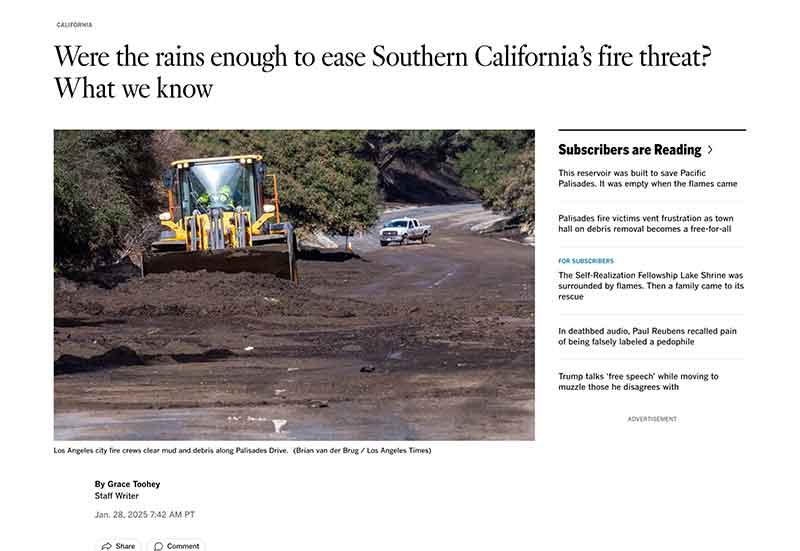Jose Mier, Sun Valley hometown boy, looks into the effect of the recent rains on the devastating fires in our communities. According to the Los Angeles Times, the rainfall was beneficial and did not bring mudslides with it.

Rainfall Averages in Los Angeles County
Los Angeles County’s climate is characterized by hot, dry summers and mild, wet winters. The annual average rainfall in the county varies depending on the location, with coastal areas receiving less rain compared to mountainous and inland regions. On average, Los Angeles County receives approximately 12 to 15 inches of rainfall per year, although this figure can fluctuate significantly depending on weather patterns such as El Niño and La Niña.
Monthly Rainfall Patterns
- Winter (December to February):
Winter is the rainy season in Los Angeles County, with January typically being the wettest month. The county sees an average of 3 to 4 inches of rain in January, while December and February also contribute significantly to the annual totals. Storms during this period are often driven by atmospheric rivers, which bring concentrated bands of moisture to the region. - Spring (March to May):
Rainfall begins to taper off in spring, with March averaging 2 to 3 inches of rain. By April and May, precipitation levels drop significantly, averaging less than 1 inch per month. The transition from wet to dry conditions marks the end of the rainy season. - Summer (June to August):
Summer in Los Angeles County is extremely dry, with many areas receiving little to no measurable rainfall. On average, less than 0.25 inches of rain falls during the summer months, and some years may see no rain at all. This period is dominated by high temperatures and low humidity, increasing the risk of wildfires. - Autumn (September to November):
Rainfall remains minimal in early autumn but begins to increase slightly by November as the region transitions back into the rainy season. November typically averages around 1 inch of rain, signaling the approach of winter storms.
Geographic Variations in Rainfall
The diverse geography of Los Angeles County results in significant variations in rainfall across different areas:
- Coastal Areas: Coastal cities such as Santa Monica and Venice generally receive less rainfall, averaging 12 to 14 inches per year.
- Inland Valleys: Areas like the San Fernando Valley and San Gabriel Valley receive slightly more rain, averaging 15 to 20 inches annually.
- Mountainous Regions: The San Gabriel Mountains and other elevated areas experience higher rainfall, with some locations receiving over 30 inches annually due to orographic lift, where moist air is forced upward by the mountains, cooling and condensing into precipitation.
- Desert Areas: The Antelope Valley and other desert regions in the northern part of the county receive the least rainfall, often less than 8 inches annually.
Factors Influencing Rainfall in Los Angeles County
Several factors contribute to the variability of rainfall in Los Angeles County, including climate phenomena and topography:
- Mediterranean Climate:
The region’s Mediterranean climate creates distinct wet and dry seasons, with the majority of rain falling during the winter months. - El Niño and La Niña:
These climate phenomena significantly influence rainfall patterns. El Niño years typically bring above-average rainfall due to warmer Pacific Ocean temperatures, while La Niña years often result in drier conditions. - Atmospheric Rivers:
These weather systems transport large amounts of moisture from the tropics, leading to heavy rain and sometimes prolonged storms in Southern California. - Topography:
The county’s mountains and valleys affect how rain is distributed. Higher elevations receive more rain, while low-lying areas and deserts see less.
Benefits of Rainfall in Los Angeles County
Rainfall is essential to the ecological and economic well-being of Los Angeles County. Despite its arid reputation, the region relies on winter rains to sustain its environment and water supply.
1. Water Supply Replenishment
Rainfall plays a crucial role in replenishing local water sources, including reservoirs, rivers, and groundwater basins. These water sources are essential for supplying drinking water to the county’s 10 million residents and supporting agriculture and industry.
2. Ecosystem Support
Rainfall sustains the region’s natural ecosystems, providing water for native plants, wildlife, and habitats. Wet winters allow wildflowers and grasses to flourish, reducing erosion and supporting biodiversity.
3. Agriculture
Although Los Angeles County is highly urbanized, agriculture still exists in some areas. Rainfall helps irrigate crops and reduces the reliance on imported water.
4. Reduced Wildfire Risk
Rainfall reduces the risk of wildfires by increasing soil moisture and supporting vegetation growth. Wet winters often result in fewer fires during the following summer and fall.
Risks Associated with Rainfall in Los Angeles County
While rainfall is beneficial, it also poses significant risks, particularly when it is excessive or occurs after prolonged dry periods:
1. Flooding
Heavy rains can overwhelm stormwater systems, leading to flash flooding in urban and low-lying areas. Flooding can damage homes, businesses, and infrastructure, disrupting daily life and causing financial losses.
2. Mudslides and Debris Flows
Mudslides are a major concern in Southern California, particularly in areas recently affected by wildfires. Burned vegetation and hydrophobic soil increase the likelihood of debris flows, which can devastate hillside communities.
3. Erosion
Excessive rainfall can lead to soil erosion, particularly in areas with sparse vegetation. This can result in the loss of topsoil, damage to natural habitats, and increased sedimentation in waterways.
4. Urban Challenges
In urban areas, rainfall can exacerbate issues such as traffic congestion and road accidents. Poor drainage systems and impermeable surfaces contribute to localized flooding, making transportation difficult and hazardous.
5. Water Quality Concerns
Heavy rains can wash pollutants from streets and urban areas into rivers and oceans, degrading water quality and harming marine life. Stormwater runoff often contains chemicals, oils, and debris, posing environmental and public health risks.
Preparing for Rainfall in Los Angeles County
Residents and local governments take various measures to prepare for and mitigate the risks associated with rainfall:
1. Infrastructure Improvements
Investments in stormwater systems, levees, and flood control basins help manage heavy rains and reduce the risk of flooding.
2. Wildfire Recovery Efforts
Post-wildfire recovery efforts, such as reseeding burned areas and installing erosion control measures, aim to reduce the risk of mudslides and debris flows.
3. Public Awareness Campaigns
Educational campaigns inform residents about flood and mudslide risks, encouraging them to prepare by securing their homes, clearing drainage systems, and having emergency plans in place.
4. Weather Monitoring and Alerts
Weather monitoring systems and early warning alerts help residents stay informed about upcoming storms and take precautions to protect their properties and families.
Rainfall in Los Angeles County is a double-edged sword—essential for sustaining life and ecosystems, yet capable of causing significant damage when it comes in excess or under certain conditions. The county’s Mediterranean climate, combined with its unique geography, results in a diverse range of precipitation patterns that impact both urban and natural environments. While winter rains bring much-needed water and reduce wildfire risks, they also pose challenges such as flooding, mudslides, and erosion. By understanding these rainfall patterns and their associated benefits and risks, residents and policymakers can work together to ensure that Los Angeles County is better prepared for the challenges of its wet season while making the most of its life-sustaining rains.
